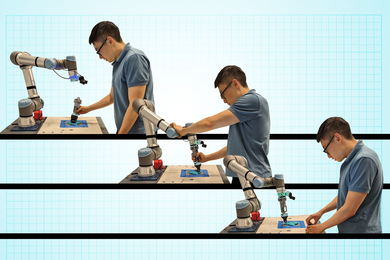Three groups of MIT students honored the legacy and leadership of the late Margaret MacVicar, the first dean of undergraduate education and founder of the Undergraduate Research Opportunities Program, in a lively multimedia session called, "Knowledge and Action: MIT Students Around the World."
The students presented their experiences in innovative educational programs that provide the opportunity to study and work abroad, or to develop products for use by local or international communities.
"Knowledge and Action," held Friday, March 1, in Room 6-120, was the afternoon segment of the 2002 MacVicar Day Celebration and followed the announcement of this year's MacVicar Faculty Fellows.
The students represented the Cambridge-MIT Institute (CMI); Service Learning , and the MIT International Science and Technology Initiative (MISTI).
In his opening remarks, Robert P. Redwine, dean for undergraduate education, recalled MacVicar's "extraordinary, unique contribution to undergraduate education." Redwine acknowledged Professors Dava J. Newman and J. Kim Vandiver, who worked with him to plan the MacVicar Day program, and Helen Samuels and Joan O'Brien for their supportive efforts.
CONTRASTING CAMBRIDGES
Professor John Vander Sande, executive director of CMI at MIT, led a live videoconference among nine students participating in the exchange program. CMI, a strategic alliance established in July 2000, includes an exchange program for undergraduates from MIT and the University of Cambridge in England. Rebecca Griffiths, Maral Shamloo and Tim Richards, the Cambridge University students currently studying at MIT, were joined by MIT students Gina Kim and Kevin Lang, who participated in the exchange last year. The four MIT students who participated from England were Raag Airan, Ketan Vyas, Tilke Judd and Marc Farrell.
In comparing the educational styles and the social lives of the institutions, students on both sides of the Atlantic noted differences in course loads, guidance by faculty, independent learning, dining traditions, ideas of relaxation, time management and philosophies of testing and grading.
Griffths told the audience how odd it struck her that people at MIT "picked up their food and took it back to their rooms." In contrast to MIT, where the dining facilities are open for three hours, dining halls in the UK are open for only 45 minutes and meals are always a shared community activity.
Kim, a senior in mechanical engineering who participated in CMI last year, described the formal hall dinners--formal as in dress and a five-course dinner--that the British students consider a relaxing break from their studies.
The students also contrasted the style of testing at MIT, which uses problem sets and regular exams to provide continual evaluation, with the year-end comprehensive exams at Cambridge University. The Cambridge students felt that the comprehensive exams required a thorough understanding of all the materials that had been covered in their previous years.
LEARNING THROUGH SERVICE
Amy Smith, an instructor in electrical science and engineering, introduced the service learning session. A former Peace Corps volunteer and the winner of the 2000 Lemelson-MIT Student Prize, Smith has worked to promote service learning as a means for students to learn while working on projects that will benefit local, national and international communities.
Service Learning, a joint venture of the Public Service Center and the Edgerton Center, was introduced in 2000-01 as a means of helping students apply their classroom knowledge to community service projects. Its programs include the Public Service Design Seminars and the IDEAS competition. It is supported by the Massachusetts Campus Compact and the d'Arbeloff education initiative, as well as the Office of the Dean for Student Life.
Arthur Musah, a sophomore in electrical engineering and computer science (EECS), described a design seminar that developed a way to make charcoal briquettes from cassava flour and sawdust, a waste product of the timber industry in Ghana.
Musah, who is from Ghana, explained how residents of villages could make charcoal briquettes for cooking from readily available materials and equipment. The components of the system were simple, including a coffee can, a galvanized bucket and bags of flour and sawdust.
"The class provided me with the very best experience, combining engineering and design. It was very rewarding because of the implications for the community I come from," Musah said.
Freshmen Ian Collier and Heather Felix showed how building toys for the Codman Square Health Center in Dorchester helped them learn design tools that were part of the curriculum for their freshman advising seminar. Their group designed and will complete 60 wooden trucks and other toys for donation to the center.
INTERNATIONAL EDUCATION
Richard Samuels, director of the Center for International Studies (CIS) and acting director of the MIT International Science and Technology Initiatives, provided some background about MISTI and introduced two student presenters.
MISTI, created in 1994, has programs allowing students to work and study in China, France, Germany, India, Italy and Japan, providing paid internships of two to 12 months and intensive study in language and culture. Samuels opened by discussing the history of the programs and their mandate to educate MIT students by providing "hands on" situations, and sending those students around the world prepared with the knowledge and skills they need to be successful. MISTI has developed unique problem-solving training involving case studies and simulations that are designed to provide both cultural and language training.
Navid Sabbaghi, a graduate student in EECS, discussed the "Raw Fish: Introduction to Japan" course he took last fall and demonstrated the challenges and excitement of intensive cross-cultural study. For a case study, Sabbaghi used a digital storyboard showing how the life of one man in Japan could be profoundly and permanently altered by long-held beliefs about obligation, debt, family and community.
Armando Herrera-Reyna, a junior in EECS, described his two internships in Germany, the second at Daimler Chrysler. The presentation discussed both the technical challenges he faced with his design team, and how his language and cultural training allowed him to work and socialize with his new colleagues.
A version of this article appeared in MIT Tech Talk on March 6, 2002.






